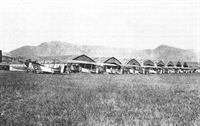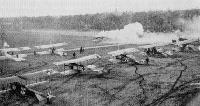
Описание
Страна: Германия
Год: 1913
Фронтовой самолет
Варианты
- Aviatik - B.I / B.II / P.15 - 1913 - Германия
- SAML - A.1/A.2/A.3 - 1915 - Италия
- Лебедев - Лебедь-IX - 1915 - Россия
- Колпаков-Мирошниченко Л.Д. - К-1 - 1916 - Россия
- SAML - S.1/S.2 - 1917 - Италия
- В.Кондратьев Самолеты первой мировой войны
- O.Thetford, P.Gray German Aircraft of the First World War (Putnam)
- J.Herris Aviatik Aircraft of WWI (A Centennial Perspective on Great War Airplanes 10)
- P.Grosz, G.Haddow, P.Shiemer Austro-Hungarian Army Aircraft of World War One (Flying Machines)
- E.Hauke, W.Schroeder, B.Totschinger Die Flugzeuge der k.u.k. Luftfahrtruppe und Seeflieger 1914-1918
- Журнал Flight
-
J.Herris - Aviatik Aircraft of WWI /Centennial Perspective/ (10)
Aviatik (P15) B.529/15.
-
J.Herris - Development of German Warplanes in WWI /Centennial Perspective/ (1)
Aviatik B (P15) B.549/15 flown by Hptm. Hugo Geyer
-
J.Herris - Aviatik Aircraft of WWI /Centennial Perspective/ (10)
Aviatik (P15) B.549/15 flown by Hptm. Hugo Geyer.
-
J.Herris - Aviatik Aircraft of WWI /Centennial Perspective/ (10)
Aviatik (P15) B
-
J.Herris - Aviatik Aircraft of WWI /Centennial Perspective/ (10)
Aviatik (P15) in Turkish Service.
-
J.Herris - Aviatik Aircraft of WWI /Centennial Perspective/ (10)
This photo of an Aviatik B model P15 was distributed as a Sanke card.
-
M.Dusing - German Aviation Industry in WWI. Volume 1 /Centennial Perspective/ (84)
Pilot Stoffler and his Aviatik P15 after the record flight to Warsaw (1913).
-
J.Herris - Aviatik Aircraft of WWI /Centennial Perspective/ (10)
The German Air Service entered the war with a number of types. Most, as with the RFC, were tor reconnaissance duties. Among the best was the Aviatik B.1 as shown here.
-
K.Delve - World War One in the Air /Crowood/
The Aviatik BII had been phased out of operational use but was still in use with training schools - as shown by the 'S' on the airframe of this example.
-
J.Herris - Aviatik Aircraft of WWI /Centennial Perspective/ (10)
Factory photographs of Aviatik B.231/13 show the refined lines, including fixed fin, of the P15 model. The engine was a 100 hp Mercedes D.I.
-
J.Herris - Aviatik Aircraft of WWI /Centennial Perspective/ (10)
Aviatik P15 B.491/15 is probably on training duty in Germany.
-
J.Herris - Aviatik Aircraft of WWI /Centennial Perspective/ (10)
Aviatik P15 B.505/15 is in the foreground of this unit lineup. Behind it is an LVG B-type, an Albatros B-type, and another Aviatik P15 B-type. These three aircraft types formed the core of early German reconnaissance units.
Другие самолёты на фотографии: Albatros B.II - Германия - 1914LVG B.I - Германия - 1914
-
J.Herris - Aviatik Aircraft of WWI /Centennial Perspective/ (10)
The Aviatik B.II appeared in limited numbers during 1915 as a two-seat reconnaissance aircraft powered by a 120hp Mercedes DII. Note the identification crosses on the underside of the upper wing and, unusually, on the wheel hubs.
-
J.Herris - Aviatik Aircraft of WWI /Centennial Perspective/ (10)
Aviatik P15 B.558/15 represents the final configuration of the Aviatik B-type P15 model with 120 hp Mercedes D.II engine. It was captured by the French in September 1915 in excellent condition and photographed for posterity. B.558/15 wears its factory markings and finish with no unit or personal markings.
-
J.Herris - Aviatik Aircraft of WWI /Centennial Perspective/ (10)
Aviatik P15 B.576/15 with a bad wheel and no gravity tank under the wing. This was the final configuration of the Aviatik B-type that was developed into the Aviatik C.I.
-
J.Herris - Aviatik Aircraft of WWI /Centennial Perspective/ (10)
Aviatik B-types in the production batch 1320-1355/15 were definitely designated as Aviatik B.II. These aircraft had 120 hp Mercedes D.II engines and, with their greater payload, were used for bombing. B.II 1329/15 is shown above and 1323/15 is at left.
-
J.Herris - Aviatik Aircraft of WWI /Centennial Perspective/ (10)
These two Aviatik B-types look like the Aviatik B.II, but their serial numbers are not visible so it is not possible to verify they are from the production batch 1320-1355/15 or were Aviatik B.II. However, they appear to have had 120 hp Mercedes D.II engines.
-
J.Herris - Aviatik Aircraft of WWI /Centennial Perspective/ (10)
Two-bay Aviatik P15 models. The aircraft at right appears to have wooden wheels to conserve rubber.
-
R.Gentilli - Italian Aviation Units in the First World War. Vol.5 /Aeronaut/ (5)
An Aviatik at Venaria Reale airfield
-
R.Gentilli - Italian Aviation Units in the First World War. Vol.5 /Aeronaut/ (5)
Some of the airplanes of the 350a Squadriglia at El Palomar airfield, Argentina: two Aviatiks, a Fiat R.2, two Farmans, a Caproni Ca.5.
Другие самолёты на фотографии: Caproni Ca.5 (Ca.44 - Ca.47) - Италия - 1917FIAT R2 - Италия - 1918Maurice Farman MF.11 Shorthorn - Франция - 1913
-
J.Davilla - Italian Aviation in the First World War. Vol.2: Aircraft A-H /Centennial Perspective/ (74)
One FIAT R.2, two Aviatiks, two Farmans, and one Caproni, at El Palomar, Argentina.
Другие самолёты на фотографии: Caproni Ca.5 (Ca.44 - Ca.47) - Италия - 1917FIAT R2 - Италия - 1918Maurice Farman MF.11 Shorthorn - Франция - 1913
-
R.Gentilli - Italian Aviation Units in the First World War. Vol.5 /Aeronaut/ (5)
Aviatiks at the officers' flying school of Montecelio, near Rome.
-
R.Gentilli - Italian Aviation Units in the First World War. Vol.5 /Aeronaut/ (5)
A long line of Aviatiks at Pratoni, one of the fields at Foiano della Chiana.
-
O.Thetford, P.Gray - German Aircraft of the First World War /Putnam/
A varied collection of two-seaters at a German airfield in 1915. The aircraft are Albatros B IIs , Aviatik B Is and B IIs.
Другие самолёты на фотографии: Albatros B.II - Германия - 1914
-
A.Imrie - German Bombers /Arms & Armour/
Aviatik B type biplanes of BAO on Allenstein aerodrome on the Eastern Front in April 1915 before taking off for Lomza. Completely mobile, housed in special railway trains, the BAO could be easily moved to different parts of the Front as required. The aeroplanes were often flown solo, allowing the weight of the observers to be used for increased fuel and bombloads. The effect of this force led to the creation of a second Brieftauben Abteilung at Metz, which additionally included aerial fighting in its duties. To differentiate between this unit and BAO, it was known as Brieftauben Abteilung Metz (BAM). These two formations formed the nucleus of the German bomber arm.
-
M.Dusing - German Aviation Industry in WWI. Volume 1 /Centennial Perspective/ (84)
Viktor Stoeffler with an LVG DD (???)
-
A.Imrie - German Bombers /Arms & Armour/
The crew of an Aviatik B category machine from Feldflieger Abteilung 9b at Colmar, well wrapped up against the elements and about to leave on a reconnaissance flight during Winter 1915, show their 25cm hand-held camera and the two 4.5kg Carbonit bombs to be dropped on targets of opportunity. These will be carried by the observer in the front seat, hung by their carrying handles on any suitable projection. He will then have to undo the safety wires, remove the pins, and either hand the bombs to the pilot for release or lean precariously aft out of his cockpit as he throws them over the side.
-
P.Grosz, G.Haddow, P.Shiemer - Austro-Hungarian Army Aircraft of World War One /Flying Machines/
The Aviatik Av.02, (Type P.15) at Flik 8 in Krakau, December 1914. It saw active service from January 1915 until September 1915 and served as a trainer from December 1915 until it was written off in June 1917. Dual controls were not fitted.
-
A.Olejko - Habsburg Wings 1915 /Aeronaut/
Miechow 1915... At the Flik 8 field airfield Aviatik B.I aircraft no.19. KVH Beskydy collection
-
A.Olejko - Habsburg Wings 1915 /Aeronaut/
Przemysl windows to the free world... Aviatik B.I plane at the Przemysl-Zurawica fortress airport - collection of the SAW-KA Wien
-
A.Olejko - Habsburg Wings 1915 /Aeronaut/
Everyday aviation... Aviatik B.I postal plane at the Przemysl-Zurawica fortress airport - collections of the SAW-KA Wien
-
A.Olejko - Habsburg Wings 1915 /Aeronaut/
Aviatik B.II Rosa after a rough landing. Source: Aeronaut.
-
J.Herris - Aviatik Aircraft of WWI /Centennial Perspective/ (10)
Aviatik P15 B-type in Turkish service.
-
J.Herris - Aviatik Aircraft of WWI /Centennial Perspective/ (10)
Aviatik P15 B.522/15 is photographed with its abashed pilot after an incident at Flieger-Ersatz-Abteilung 2.
-
J.Herris - Aviatik Aircraft of WWI /Centennial Perspective/ (10)
Aviatik P15 B.279/13 after a serious head stand.
-
A.Imrie - German Bombers /Arms & Armour/
The belly of this crashed Aviatik B II from Feldflieger Abteilung 34 shows the two bomb chute exits and the celluloid-covered downwards viewing panel immediately ahead. Two 10kg Carbonit bombs were suspended in the chutes in the pilot's cockpit beside his knees. On a bombing run the pilot rested his head on the crash pad and viewed the ground through the transparent panel; he used an intersection of fuselage bracing wires as a sight, unhooking the bombs at the appropriate moment.
В.Кондратьев Самолеты первой мировой войны
АВИАТИК B-I/B-II / AVIATIK B-I/B-II
Немецкая фирма Аутомобил-унд-Авиатик из Мюльхаузена (Эльзас) выпустила в 1914-1916 годах несколько типов военных многоцелевых аэропланов. "Остроносые" деревянные бипланы с тянущими винтами и рядными моторами водяного охлаждения - этой схемы придерживалось тогда подавляющее большинство германских авиапредприятий.
Открыл серию "Авиатик" B-I (заводское обозначение P.15A), появившийся незадолго до начала Первой мировой войны. Двухместный аэроплан без вооружения с двух- или трехстоечной бипланной коробкой применялся в качестве разведчика на западном и восточном фронтах примерно до начала 1915 года.
Единственным оригинальным моментом в этой машине была ярко выраженная стреловидность крыльев, унаследованная от довоенной разработки фирмы Авиатик - аэроплана "Пфайль" ("Стрела"). Считалось, что это обеспечивает самолету повышенную продольную устойчивость. Следующим стал "Авиатик" B-II (P.15B), отличавшийся более мощным мотором.
ДВИГАТЕЛЬ
"Мерседес", 100 л.с. (B-I) или 120 л.с. (B-II)
Описание:





































